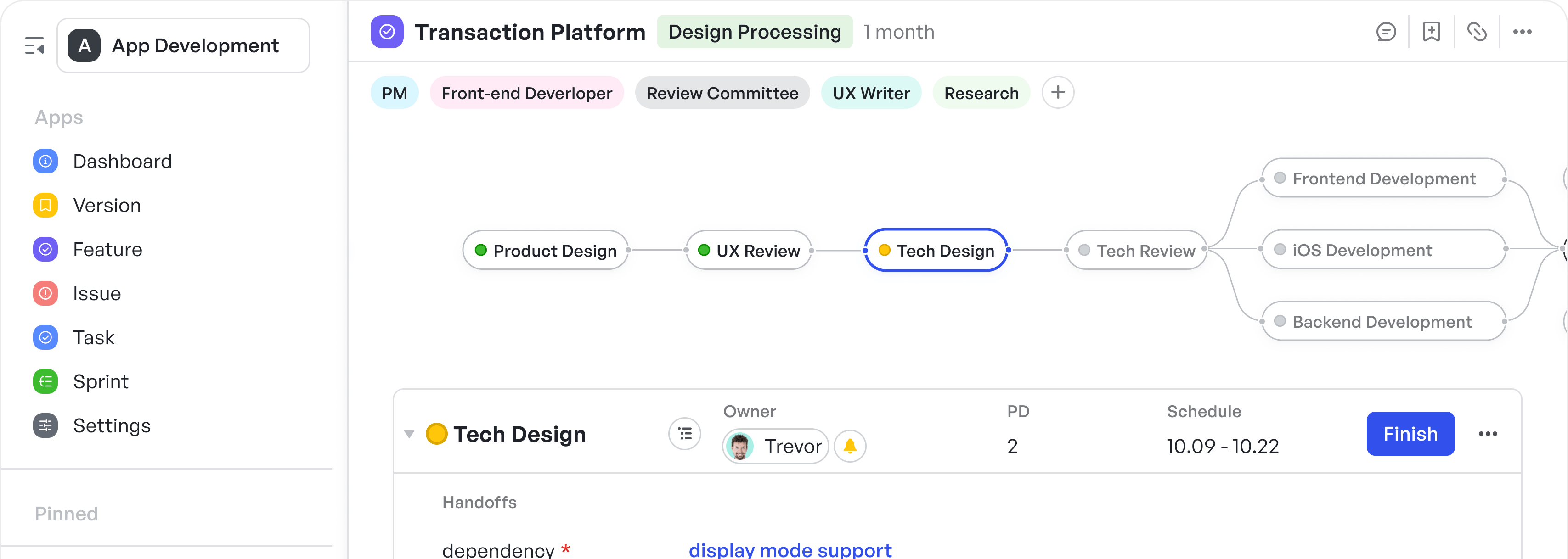Getting work done as a team isn't easy. Whether you're organizing a product launch or planning next month's marketing campaigns, you need a way to keep everyone on the same page and moving in the right direction.
Asana has become very popular, with over 12,000 businesses using this tool, including Amazon, Walmart, and Apple. Monday.com follows closely, with over 10,000 users. Let's take a closer look at what makes each tool special, so you can figure out which would work better for your team.
Our comparison article will simplify the key differences between these leading project management solutions. We'll examine their features, pricing structures, and specific use cases to help you determine which platform best aligns with your organization's needs.
Throughout this analysis, we'll explore:
- Core features and capabilities
- User interface and ease of use
- Pricing models and value proposition
- Integration ecosystems
- Team collaboration features
- Best-fit scenarios for different business needs
Let's dive into a detailed comparison of these two powerful project management tools to help you make the best decision for your team.
Both Asana and Monday.com approach task management with philosophies that reflect their origins and target use cases. Let's examine how each project management tool handles essential task management features and where they excel or fall short.
Task creation and organization
Asana provides an intuitive task creation system built around portfolios and projects. Its standout feature is a task hierarchy that supports up to five levels of subtasks, enabling teams to break down complex projects into manageable components.
Tasks can be viewed in multiple formats — lists, board, calendar, and timeline — with custom fields for detailed categorization and filtering. All task updates automatically sync across all views and projects that ensure consistency throughout the platform.
250px|700px|reset
加载中,请稍后
In contrast, Monday.com takes a more visual approach to task management, using customizable items that can represent tasks, projects, or any unit of work. The platform's flexible column system allows teams to add and customize any type of information for tasks. A robust color-coding system provides a quick- visual representation of task status, while real-time updates keeps team members informed of changes as they occur.
250px|700px|reset
加载中,请稍后
Let’s dig a little deeper.
Task dependencies and relationships
Task dependency management highlights notable differences between the two platforms. Asana offers a structured approach with multiple dependency types, such as start-to-start and finish-to-start relationships.
The Start-to-Start (SS) dependency allows tasks to progress in parallel, as seen in scenarios like starting a social media campaign only after the associated webpage has begun development.
250px|700px|reset
加载中,请稍后
The Start-to-Finish (SF) dependency requires Task B to start before Task A finishes, which is particularly useful in scenarios needing continuity, such as shift transitions where one operator’s shift doesn’t end until the next begins.
250px|700px|reset
加载中,请稍后
Automated notifications alert users when dependent tasks are completed, and the timeline view offers clear visualization of dependencies, including impact analysis for changes to dependent tasks.
Asana also uses auto-shifting dates that dynamically adjust schedules based on dependencies.
Monday.com manages dependencies through its connect items feature, offering a more flexible but less structured approach. While it provides visual dependency mapping and real-time updates when linked items change, the system favors adaptability over rigid structure.
This makes it particularly suitable for teams that need to frequently adjust task relationships. However, those seeking the rigid frameworks common in traditional project management methodologies should look for other options.
250px|700px|reset
加载中,请稍后
In summary here's where both tools stand on task dependencies:
Advanced task features
When it comes to recurring tasks and multiple assignees, each platform shows distinct strengths. Asana excels in recurring task management, offering flexible scheduling options that include daily, weekly, monthly, or custom intervals. Users can set end dates, automatically skip weekends, and adjust individual due dates without affecting the series, making it highly efficient for routine task planning..
Monday.com, while offering basic recurring task functionality, truly shines in its handling of multiple assignees. Unlike Asana's limitation of one primary assignee per task, Monday.com allows multiple team members to be assigned to a single task. Each assignee's progress is clearly tracked, making this feature particularly valuable for collaborative projects where responsibilities are shared among team members.
Project views and visualization
The way teams visualize and interact with their project data greatly impacts productivity and clarity. Both Asana and Monday.com offer multiple views to accommodate different project management styles, though they approach visualization with distinct philosophies.
Core project views
250px|700px|reset
加载中,请稍后
Asana simplifies visualization with five essential views that users can switch between instantly with no additional setup. The list view functions like an advanced spreadsheet, allowing teams to organize tasks with sections and columns that can automatically calculate sums and averages. The Kanban board view presents tasks as cards that can be dragged between columns representing workflow stages, with each card displaying key details like due dates, assignees, and subtasks for easy tracking.
With 27 different views to display project data, Monday.com offers a broader range of visualization options. Its Kanban view provides similar drag-and-drop functionality to Asana's, but with added customization options for card appearance and column behaviors. The platform's list view focuses on visual customization, allowing teams to use color-coding and multiple column types to create highly tailored layouts.
250px|700px|reset
加载中,请稍后
Timeline and gantt capabilities
Both platforms offer timeline and Gantt chart views, but with unique strengths. Asana's timeline view emphasizes simplicity and quick setup, allowing teams to create project timelines in seconds while clearly highlighting task dependencies. The Gantt view helps monitor progress against target schedules and visualize dependency chains, ensuring deadlines are met with minimal confusion.
Monday.com's Gantt capabilities are more robust, offering features that make complex projects more manageable. Teams can create multiple timeline views simultaneously using the Dashboard Feature, providing a comprehensive overview of various project schedules. This flexibility makes Monday.com particularly valuable for organizations juggling multiple concurrent projects.
Calendar view
Calendar views are quite popular for tracking schedules and deaslines.
Asana's calendar view provides straightforward, user-friendly interfaces for schedule visualization. Tasks can be rescheduled via drag-and-drop functionality, automatically updating due dates to maintain workflow accuracy.
250px|700px|reset
加载中,请稍后
Monday.com extends this functionality with a multi-level calendar system that can be viewed by month, week, or day, helping teams manage both immediate and long-term scheduling needs.
250px|700px|reset
加载中,请稍后
Dashboard and reporting features
Asana offers project reporting and dashboards focused on essential metrics and progress tracking. Monday.com provides more extensive customization options with its dashboard system, including specialized widgets for different data types — from battery-style status indicators to workload analysis tools that help manage team capacity.
One of the specialized widgets includes a unique Numbers widget for financial tracking and offers extensive chart options for visualizing data in ways that make sense for your team.
Teams can pull data from multiple boards to create comprehensive views, whether you need to track budget spending, monitor project timelines, or analyze team performance.
250px|700px|reset
加载中,请稍后
Asana's reporting focuses more on project progress and goal tracking, with cleaner but less customizable visualization options.
250px|700px|reset
加载中,请稍后
Key Takeway: Asana prioritizes simplicity and immediate usability, while Monday.com emphasizes customization and diverse visualization options.
Workflow management and collaboration
Both Asana and Monday.com offer robust workflow automation and team communication features, though they approaches differ in design and functionality.
Workflow automation
Asana focuses on creating straightforward, code-free automation through its Rules feature. Users can build customized workflows that automatically trigger actions based on changes in task status, due dates, or assignments. The platform emphasizes scaling reliable, error-proof processes across organizations while maintaining simplicity in setup.
250px|700px|reset
加载中,请稍后
Monday.com takes a more comprehensive approach to workflow automation, building it into the core of their Work OS platform, rather than offering it as an add-on. Their system allows for extensive customization of automated processes, with particular strength in standardizing repetitive tasks and maintaining consistent communication practices. The platform excels at creating reusable workflow templates that can be quickly modified for different projects.
250px|700px|reset
加载中,请稍后
Automation capabilities by platform
Asana:
- Pre-built automation rules for common scenarios
- Custom rule creation without coding
- Process bundles for managing multiple workflows
- Automatic task assignments and status updates
- Integration with 270+ apps for cross-platform automation
- Built-in automation recipes for quick setup
- Priority-based task delegation
- Custom templates for recurring workflows
- Automated status tracking and updates
- Cross-board automation capabilities
Team collaboration features
Asana integrates collaboration directly into task management through features like Forms, which standardizes work requests and ensures teams have necessary information from the start. Their real-time updates and commenting system keep team members informed about project progress.
250px|700px|reset
加载中,请稍后
One-on-one meeting with a task list on the left and conversation/comments on the right - Source: Asana
Monday.com emphasizes consistent communication practices through their Updates section, which maintains context-specific discussions within tasks. Their system promotes real-time, in-context communication threads rather than scattered emails or messages.
250px|700px|reset
加载中,请稍后
Document management and file sharing
Asana provides integrated file-sharing capabilities with major cloud storage providers and maintains version history for uploaded documents. Their system focuses on keeping files organized within the context of specific tasks and projects.
Monday.com is a project management platform that offers a more visual approach to file management with their Files Gallery view, allowing teams to manage documents, images, and contracts in a consolidated, gallery-like format. This makes it particularly effective for teams that frequently work with visual assets or need to maintain extensive document libraries.
250px|700px|reset
加载中,请稍后
Managing cupcake orders with columns for Order ID, Files, and Person assignments - Source: Monday.com
Real-time collaboration
Both platforms support real-time collaboration.
Asana:
- In-line task comments and discussions
- Real-time complete progress status
- Shared project calendars
- Collaborative project timelines
- Task dependency tracking
- Real-time board updates
- Collaborative document editing
- Live team communication within tasks
- Shared workspace updates
- Instant notification system
Key takeaway: Asana's approach may better suit teams focused on rapid execution, while Monday.com's comprehensive collaboration features might better serve teams requiring extensive communication and document management capabilities.
Pricing comparison
Let's analyze the pricing structures of both Asana and Monday.com to understand their value propositions across different tiers.
Asana pricing tiers
- Basic (Free)
- For individuals and small teams up to 10 people
- Unlimited essentials (projects, tasks, storage, comments)
- Starter - $10.99/user/month (billed annually)
- Five project views including timeline and Gantt
- Automated workflows (250 automations/month)
- Asana AI features
- Project reporting and dashboards
- Unlimited free guests
- Advanced - $24.99/user/month (billed annually)
- Portfolio features
- Enterprise (Custom pricing)
- Unlimited portfolio views
- Advanced authentication
- Custom branding
- Universal workload management
- AI Studio for smart workflows
- Individual Plan (Free for up to 2 users)
- Basic features for personal use
- Basic Plan - $10/user/month
- Essential features for small teams
- Standard Plan - $12/user/month
- Additional features like timeline views and integrations
- Pro Plan - $20/user/month
- Advanced features including time tracking and automation
- Enterprise Plan (Custom pricing)
- Comprehensive features and dedicated support
Key pricing differences
User experience and interface design
250px|700px|reset
加载中,请稍后
Initial setup and learning curve
Asana prioritizes a simple onboarding experience with an intuitive initial setup process. However, its task template system has been reported as complex, with users like project managers finding the process of manually adding tasks and configuring settings somewhat tedious and error-prone. The platform's learning curve is moderate, with basic functions being easily accessible but more advanced features requiring dedicated time to master.
Monday.com presents a more challenging initial experience due to its extensive feature set. New users often report feeling overwhelmed by the numerous options and choices available from the start. While this complexity offers greater flexibility, it can create a steeper learning curve, particularly for those new to project management tools.
Interface design and navigation
Asana's interface emphasizes clarity and simplicity, with a clean design that has earned it user preference in terms of user-friendliness. The platform maintains consistent navigation patterns and clear visual hierarchies, making it easier for teams to assign tasks, locate key features and information.
Monday.com's interface is more feature-rich but can feel cluttered to new users. While it offers extensive customization options, the abundance of features and views can make navigation more challenging, particularly for users who prefer straightforward interfaces.
Mobile experience
Both platforms offer mobile apps. The standout difference is that Asana focuses on simplicity, while Monday.com gives you a richer view of what you need to see.
Asana:
- Clean, simplified mobile interface
- Focus on essential task management features
- Smooth synchronization with desktop version
- Optimized for quick updates and task tracking
- Feature-rich mobile experience
- Strong visual customization options
- Real-time collaboration capabilities
- Can feel overwhelming on smaller screens
Security and administration
250px|700px|reset
加载中,请稍后
Security and administrative controls are crucial factors for organizations selecting project management software.
Security certifications and compliance
Both platforms maintain strong security credentials, with Asana being used by 85% of Fortune 100 companies and offering SOC 2 compliance, HIPAA compliance, and enterprise key management (EKM). The platform operates data centers across the US, Europe, Japan, and Australia, ensuring global coverage and data sovereignty compliance.
Monday.com matches these standards with its own set of certifications, including HIPAA, SOC 2, GDPR, and ISO 27001 compliance. Their infrastructure is hosted on AWS and Google Cloud Platform with data centers in the US and Germany.
Data protection and access control
Asana provides comprehensive data protection through multiple security layers, including two-factor authentication, SAML integration, Google SSO, and organization-wide password requirements. Their enterprise features extend to data loss prevention, SIEM integration, and eDiscovery capabilities. Access controls are granular, with object-level and centralized admin controls, guest invite restrictions, and session duration limits.
Monday.com approaches security with a similar depth, implementing two-factor authentication via both SMS and TOTP, SAML support, and Google login integration. They maintain an active bug bounty program and regular security audits. Their access control system focuses on team-based permissions and custom role definitions, with strong integration permissions and mobile device management capabilities.
Ideal use cases and best-fit scenarios
Ideal scenarios for Asana
For a team that manages project-based workflows (especially with multiple tasks and interdependent deadlines), Asana helps by using its timeline view and dependency management features to correctly map out projects comprehensively.
And for product launch coordination involving cross-collaboration-heavy projects, Asana enables shared task views, automated notifications, and progress tracking to minimize the effect of siloed management.
Accessibility for remote and hybrid teams
With features like real-time updates, mobile app support, and offline functionality - all of which are good for distributed team members to remain connected and productive regardless of locations and flexible arrangements.
Industry verticals
The platform performs exceptionally well in:
- Marketing and creative agencies requiring campaign management
- Software development teams needing sprint planning
- Professional services firms managing client deliverables
- Media companies coordinating content production
- Educational institutions organizing administrative workflows
Optimal use cases
Asana excels in scenarios such as:
- Content calendar management and editorial workflows
- Marketing campaign coordination
- Product launch planning and execution
- Client project management
- Cross-functional team collaboration
- Research and development tracking
- Event planning and coordination
Project complexity
The platform handles best with:
- Multi-phase projects requiring clear milestone tracking
- Projects with defined dependencies and sequential tasks
- Medium to large-scale initiatives requiring detailed subtask management
- Cross-departmental projects needing clear communication channels
- Projects requiring regular status updates and progress tracking
Monday.com works well as an effective CRM tool. If the business is looking to manage customer interactions, track sales pipelines and monitor clientele, this software allows you to customize boards and facilitate tracking of processes and post-event follow-ups.
Team composition
The platform works best for:
- Teams of varying sizes, from small startups to large enterprises
- Organizations with fluid team structures
- Cross-functional teams requiring multiple project views
- Teams needing high levels of workflow customization
- Organizations with multiple departments requiring different workflow styles
Industry applications
- Construction and real estate project management
- Manufacturing and production scheduling
- Creative agencies managing multiple client projects
- Sales and CRM operations
- Human resources and recruitment
- IT service management
Workflow types
The platform excels with:
- Resource-intensive projects requiring detailed tracking
- Customer-facing processes requiring status transparency
- Agile and hybrid project management methodologies
- Projects requiring multiple stakeholder views
How Meegle fits in the project management landscape
Meegle brings unique capabilities to the project management space that sets it apart from both Asana and Monday.com.
The platform's node-driven visual workflow system provides an intuitive way to map and modify project processes in real-time. This visualization approach helps teams instantly understand project structures and relationships, making complex workflows more manageable.
250px|700px|reset
加载中,请稍后
View project organization with nodes for Features, Change, Risk, and Procurement
The platform's tree view structure offers enhanced parent-child relationship visualization, providing clearer insight into project hierarchies than either Asana's limited subtask system or Monday.com's board-based approach. Combined with role-based assignments and detailed task hierarchies, Meegle enables more project organization while maintaining visual clarity.
250px|700px|reset
加载中,请稍后
View various development tasks, issues, and features with their current status and timelines
Quality management and compliance tools are built directly into the platform, with features like approval chains, quality checkpoints, and comprehensive audit trails. The platform also offers specialized templates for different industries, from software development to construction projects, providing immediate value for teams in specific sectors.
Advantages over competitors
When compared to Asana and Monday.com, Meegle offers several distinct advantages. While Asana provides basic workflow creation and Monday.com offers board customization, Meegle's workflow system includes conditional logic and adaptive workflows that can automatically adjust based on project needs. This flexibility allows for more sophisticated process automation without sacrificing usability.
Task dependencies, often a pain point in managing multiple projects, are handled more effectively in Meegle through its visual mapping system. Unlike Asana's linear dependency chains or Monday.com's column-based approach, Meegle's node system makes it easy to see and manage complex task relationships.
Industry solutions and quality control
Meegle's quality control features surpass both competitors, offering built-in review workflows, quality checkpoints, and compliance documentation tools. These features are particularly valuable for regulated industries or organizations with strict quality requirements.
The platform's industry-specific solutions provide immediate value through pre-built templates and workflows designed for particular sectors. While Asana and Monday.com offer general templates, Meegle's industry focus enables teams to implement best practices specific to their field from day one.
Which is the right project management tool?
For organizations considering migration, Meegle's visual workflow system may require initial adjustment but often results in clearer process understanding. The platform's industry templates can significantly reduce setup time, though teams should plan for proper training to utilize its more advanced features effectively.
The final choice depends largely on organizational needs:
- Choose Asana for straightforward project management with minimal complexity
- Select Monday.com for customization and tracking of processes
- Opt for Meegle when requiring workflow management, industry-specific features, or advanced quality control
For growing organizations, particularly those in regulated industries or with complex processes, Meegle's additional capabilities likely justify any learning curve associated with adoption. However, smaller teams with simpler needs for managing tasks might find Asana or Monday.com sufficient for their requirements.





